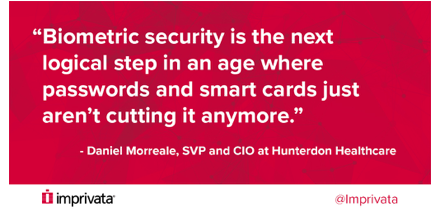Using biometric identification to improve patient safety
It is no secret that the healthcare industry is increasingly embracing new technology. Organizations continuously strive to enhance workflows and make it easier and more secure for clinicians to take care of their patients. To accomplish these goals, many hospitals look for a solution that improves patient registration, reduces the number of duplicate medical records, and increases patient safety.
In a recent webinar, Arthur Ream, Director of IT Applications and CISO at Cambridge Health Alliance, and Daniel Morreale, SVP and CIO at Hunterdon Healthcare, discussed with Anthony Guerra, editor-in-chief of healthsystemCIO.com, the ins and outs of biometrics and how they think biometric identification will positively affect the healthcare industry.
Why biometric identification?
Even with a proper government ID and insurance information, it is still possible for patient identification errors to occur at hospitals, which makes patient registration a difficult process and increases the chance of duplicate medical records. Hunterdon Healthcare was looking for a solution that would streamline registration, reduce the chance for multiple medical records, and enhance security. They decided to implement iris recognition when the realized that they wanted to put the effort and resources into something that would bring about positive patient identification and consistency. The number of people that objected to the new technology was small, due to the constant communication and information they provided to their patients.

Cambridge Health Alliance uses fingerprint biometrics at registration. Arthur Ream emphasized that if anything, the reasoning to rollout biometrics is patient safety, patient satisfaction, and reimbursement. When clinicians have accurate patient information, everyone in the organization benefits, and the result is the best possible patient care.
Increasing patient safety
Securing a patient’s health information (PHI) ensures patient safety and limits the risk of fraud. Many people with the same name or same birthday visit the same hospitals. Some people may also use a family member’s insurance information. Misidentification can lead to missed diagnoses, improper treatments, and even corrupted medical records. Hunterdon Healthcare felt that the number of duplicate and inaccurate medical records in their system was just too much, adding up to about 13-14% of their patients’ on an annual basis. With biometrics, they were able to get that number down and better treat their patients with accurate care.

The future of biometrics
As new technology is released, healthcare organizations need to ask: will this improve our patient care? Hospitals today aim to reduce the amount of patient identification errors with new systems and policies, but will that guarantee patient safety? With Imprivata PatientSecure palm-vein scanning, for example, a patient’s biometric is linked to their medical history providing a 1:1 correlation between the patient and their PHI. PatientSecure can even positively identify a person who is unconscious to correctly bring up a patient’s medical record and ensure proper treatment. Cambridge Health Alliance is currently exploring Imprivata PatientSecure to better enhance their biometric identification solution. It is often hard to find a patient identification solution that brings security and convenience together, but with solutions such as Imprivata PatientSecure that make for easier workflows and secure integration, the adoption rates can only increase to protect patients’ privacy and medical information.
Listen to the full HSCIO webinar here.
